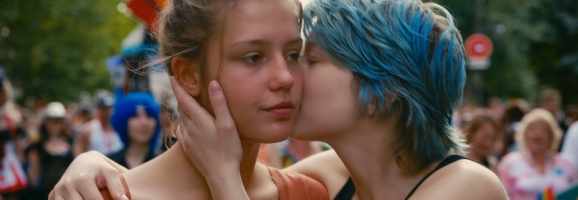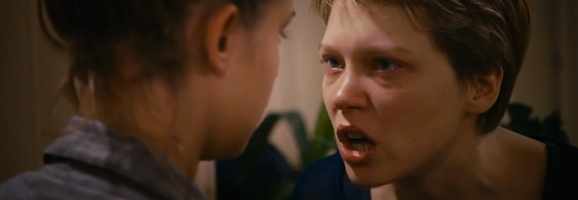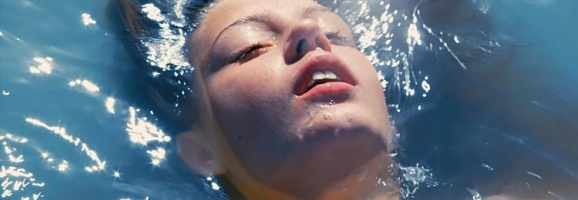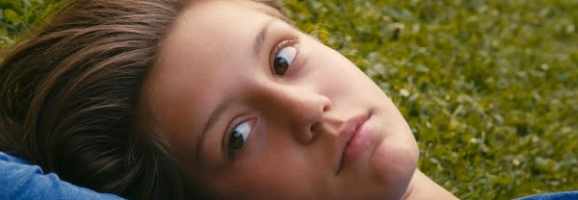Why Blue is the Warmest Colour is Worth Seeing

**This article contains some spoilers**
Upon being unexpectedly amazed by recent Palme D’Or winner Blue is the Warmest Colour, I found myself trying to pinpoint exactly what it was about that film that made it have such a profound effect on me. It is by no means the first film to do so but, considering its rather simple set-up, I find it interesting that it was so effective. Here, I attempt to locate exactly what it is about Blue that makes it such a significant film in contemporary art cinema. These are just the elements that stand out for me, I’m sure there are plenty more worth noting so please feel free to do so.
Intimacy
The French title literally translates to ‘Life of Adèle’, giving an initial clue to the film’s intimate focus on a specific character. It would be an understatement to say it just focuses on Adèle – the film is Adèle. For those of you feeling a little malnourished in the character development category, here’s just under three hours focused almost entirely on the trials and tribulations of one character. Even Emma is always shown in relation to Adèle, rather than as a character on her own. Not only is the intimate focus refreshing for those of us bombarded with Hollywood’s foregrounding of spectacle over the individual, but Adèle Exarchopoulos is wonderfully enigmatic. This is not to suggest that this has never been achieved before (Amélie, Lost in Translation, and Before Sunrise) but the real achievement here lies in the fact that Blue is the Warmest Colour has the ability to interest a dedicated viewer from start to finish.
Blue is able to keep the viewer’s interest by moving inwards rather than outwards – by the end of the film I felt I had connected more with Adèle than I had actually explored her environment. This is mainly achieved through Sofian El Fani’s cinematography, particularly the frequent use of close-ups. Abdellatif Kechiche’s decision to not allow either Adèle Exarchopoulos or Léa Seydoux to wear make-up throughout the shoot also adds to the rawness of many emotional moments. One sequence worth mentioning in particular is when Adèle and Emma meet in a café after their break-up; rather than attempting to glamorise his actresses, Kechiche chooses instead to present realism through an extended crying sequence.

It Doesn’t Drag
It is quite an achievement in itself for three hour film to be consistently interesting from start to finish, especially when its premise can be summarised so simply. A lot of my favourite films are extremely lengthy in terms of running time but most are traditional ‘epics’ in that they have expansive narratives, dozens of characters, and extend over long periods of time. Blue is quite different in this respect. On top of this, Blue isn’t pretentious in the presentation of its subject matter. It takes a long time to show something simple but, for me, this seems to be the point.
Without dedicating forthrightly to Adèle’s detailed story we would not be shown the moments in between her times with Emma. My favourite moment in the film is when Adèle dances to Lykke Li’s ‘I Follow Rivers’. This moment lasts for no more than a minute and would possibly have been lost had the film been cut down, along with many other moments used to explore Adèle’s character. It is a film full of moments like this and would not be the same without them.
Cinematic Beauty
Blue is pure cinema in the sense that it offers certain things that other mediums cannot. It utilises filmic sophistication through both cinematography and soundtrack. The transfer from graphic novel to film is well-handled through characterisation. Here, we are presented with real people but the long-form structure of the novel is kept intact through the running time and character focus. Art cinema is about beauty and Blue is a clear example of this because its narrative is not always its strong point. Just as the recent hit Gravity has shown that spectacle sells, here we have an example of a different kind of cinematic spectacle; an intimate epic in many ways.
So much of the film is dedicated to Adèle’s face and her beauty within the beauty of the medium itself. For example, the scene where she first talks to Emma in a bar is mainly comprised of shots focusing solely on Adèle and her reaction to her environment. The cinematic beauty is present in the way Kechiche is not in a hurry to establish a narrative trajectory. We become aware that a love story is about to develop but this is never a definite as we are trapped in the same situation as Adèle, unaware of whether or not she can integrate in this new environment. What is presented instead is cinematic beauty through ambiguity and character focus. Kechiche is a filmmaker looking to explore rather than explain. Most viewers will, of course, already be aware of the film’s basic premise before they see it, but this never undermines its meanderings because Kechiche takes the unexpected route through the break-up.

It Addresses a Relevant Subject Matter
Despite some controversial choices in the presentation of its subject matter, Blue addresses a relevant topic. Graphic sexuality is no longer uncommon, especially in the art cinema community, however, Blue‘s exploration of the place of lesbianism within contemporary society is still a key issue, even in the post-Brokeback era. Numerous art films function as explorations of social taboos and subversive themes (examples include XXY, Dogtooth, Eyes Wide Open) yet often fall short of truly exposing the heart of their subjects. Blue is the Warmest Colour grounds its focus on lesbianism in character and certain key settings. For example, the sequence where Adèle is confronted by her supposed friends in the school playground after she is seen with ‘tomboy’ Emma. The dialogue in this sequence is very crass, assuming the subtitles do it justice, and Kechiche does not hold back when it comes to clearly underlining how dismissive some people can be of such a sensitive subject.
A certain element that cannot possibly be overlooked in relation to this is the sex scenes. It would be naïve to suggest that these moments have not been a contributing factor in the film’s post-festival hype, despite it winning the Palme D’Or. There have been many discussions of the issues of exploitation and the fact that the film is directed by a man. When addressing this point recently, Mark Kermode said that for him “What’s really interesting about the film is the conversations and the social frictions” and he suggests that the sex scenes could easily have been shortened down. Although this is a valid point, I feel that the open expression of these scenes adds another element of intimate exposure that is so crucial to the way Blue works as a whole.
I recently found a YouTube video where lesbians were asked to give their opinions on these scenes. One particular interviewee described the first sexual encounter as like an “infomercial for a kitchen product” in the way that Kechiche attemps to show too many different elements of lesbian sexuality. The interviews in this video that these scenes are shocking enough to create a reaction but never tasteless or offensive to the gay community. This highlights the fact that Blue is still, after all, a dramatisation of reality but is by no means poorly constructed or unaware of the implications of foregrounding such a sensitive topic.
Lack of Clichés
The ending of Blue has the ability to divide audiences because of its lack of resolution in the traditional sense. For me, I think it perfectly underlines the film’s realistic approach to love and relationships; by the time the credits rolled it struck me that Blue is more of a life story than a love story. Of course it is not without some clichés – the love at first sight moment, the melodramatic confrontation when Adèle’s affair is exposed by Emma – but it is never schmaltzy or undermined by any of these tropes because of Kechiche’s bold decision to break up the relationship he has so meticulously built up. The presentation of time also helps lift the film above the average romance story as it is not completely clear how much time has passed between scenes. This allows the audience to work these elements out for themselves, creating another element of rewatchability.
It’s Relatable to Everyone
Blue is the Warmest Colour is a love/life story that addresses lesbianism in contemporary society. On face value, it could easily be dismissed as being too specifically-focused and potentially alienating to certain markets. However, it is not a direct connection between audience and narrative that makes it so relatable, but rather that it is constructed in such an intimate way that the audience becomes a part of Adèle. Viewers are never required to fully relate to her specific predicament but are instead invited to compare her situation to their own experiences of love. It is a beautifully made film and it really stayed with me as one of the most brutally honest stories I’ve seen on-screen for quite some time.

What do you think? Leave a comment.











Definitely worth seeing. Great post. Two scenes got under my skin: the first one when they face each other before saying good bye at the park, and I was on the edge of my seat waiting for a kiss, and the second one when Emma finds out about being betrayed and slaps Adele on the face. The following scene, when Adele walks away crying is one of the most devastating I’ve ever seen, you simply share all the regret she’s feeling. The fact is this movie gives you one better scene after another, until the one I think is the very best, when they meet at the cafe and Adele tries what we all get to know is her very last shot in this relationship.
I literally gasped for air during the scene where Adele is on the street and she sees Emma for the first time with her leather jacket and blue hair. The longing, the curiosity on Emma’s part. They had such good chemistry even in a scene where they just glance at each other. I cant wait to get this on DVD in February.
Adele’s walk through the lesbian bar but especially the point where Adele turns around to face the camera and Emma approaches her from behind before going elsewhere. You hold your breath because you want her to turn around so bad. Music and camera was awesome there.
It is a film that draws you into the life of it’s main character with it’s fantastic direction, sense of color symbolism, & amazing performances. It’s more than what you expect from most coming of age tales, as you really do feel as though you are a part of this young girls life, love, and heart ache in the three hour time period. The dip is a wonderful examination of growing up, and the mystery of it all. Also, there are some class/political themes that are very interesting as well & serve as quite a big part of the story. Tremendous film.
Saw movie recently and I thought it was excellent I may see it again soon because they don’t have much time for foreign language films where I live at theaters . it may get some nominations highly doubt a best picture one though I feel it’s just too out there for the academy regardless of its quality . which is a shame because IMO it’s the best film of the year but quite some distance in terms of the one’s I have seen at least really enjoy this time of year because the general quality of films is on the up and up really looking forward to seeing the likes of her , American hustle , 12 years as a slave and the wolf of Wall Street to see how they measure up.
It’s a shame that the Academy dismiss such masterpieces because they are foreign or not particularly well-known. Despite being an American award system, it shouldn’t matter where a film comes from. Having said that, you never know, maybe it will be given a well-deserved place on the list – especially following its festival win.
For me, Blue was the best movie of the year, and i have seen a lot of movies this year. Gravity and 12 years, among others, were also very good but not on the level of Blue. The story was gripping and the acting amazing. Talking about acting, Adele should win Oscar for best actress. There were no better performance by a leading actress this year, IMO. Not even Cate Blanchett for Blue Jasmine. And i would be very happy if Lea would be nominated for best supporting actress. I doubt it though. Hollywood being prudish, i doubt that the movie will win anything.
The development of each character is well depicted throughout the film. Among other things, you discover that Emma is a bit of an arriviste (she even exploits Adele on her behalf by paintings Adele’s ‘body and soul’ – therefore an indecent exposition of Adele’s intimacy), and a deep thinker (intellectual/abstract thinker), as opposed to Adele who is more down to earth/relational and concrete in her thought process (this is depicted in the party scene with her conversation with Samir(?) – her future boyfriend at the end of the film). Adele and Emma’s differing personalities draws then apart over time.
The last scene with Emma and Adele: What nails the coffin with regards to their relationship is that Emma now has a ‘family’ and it is more important for Emma than being passionately in love – she does not passionately love her new girlfriend (it is more like a long term marriage: intimacy replaces passion) and she is attached to her daughter -a bond that is very strong. Emma is older and at a later stage in her life but does realize the Cornelian choice she makes (it is a grieving process: give away passion for the lack thereof…forever). This is a subject that is very taboo and undermined in a lot of films but real. Kechiche shows this here.
Very memorable ending. I think Adele finally lets it go… she lets Emma go. Of course she will always remember her, and even love her (unless she really finds someone else to love passionately)but she wants it to end, she will try to really move on and it was nice to see that she was well enough to keep going with her work, even if the pain was there. Personally, I’m sure she will still suffer, and be empty but she will eventually move on and hopefully find someone else… and maybe again in a few years she can see Emma again in an expo. most likely, or simply not… It’s up for each viewer to make up their own closure (taking into account the ending of the film). Very raw and realistic.
I like to think of the music as bookends to their relationship. It can be heard when Adele first sees Emma in the middle on the street, and at the end when she walks away from the art exhibit. It’s tragic, but I think their relationship is done forever.
A fine discussion of a great, important film. I think some audiences aren’t going to see it because it’s three hours, about two women falling in love, and contains graphic sex scenes, but as you say, it’s relatable to anyone who’s ever been in love. I try to tell my friends that it’s not even that artsy and it’s easy to follow, but they don’t believe me!
I liked the movie, particularly the first half. The tension and sincerity in the first half somehow is toned down during the second half. It was boring. The scenes with Adele teaching in the school were really boring. I really started wishing they would stop showing close up of Adele’s face. There was such a lack of action. I know those scenes had relevance and importance for the movie but they were oh so boring.
I could cut at least 20 mins from the movie and it would make no difference. Maybe make it a bit more interesting.
I downloaded it and watched it yesterday, I thought the two main actors did a fantastic job of portraying a couple who love eachother but cant be together.
I would really like to see this movie. Haven’t been able to find it in any of my local cinemas so I’ll probably have to wait for DVD. I’ve always been a fan of “slow movies” that are just content to build their characters and let us climb into their skin and, from the sounds of your article, Blue is all about that.
Great article and such an important film. I think my favourite thing about it and the thing that will stay with me most of all is that it’s the first time I’ve ever seen a movie that involves a lesbian couple just living an everyday domestic life together. I can’t think of any other film of this scale I’ve seen in which there are scenes showing a woman cooking for her girlfriend or a woman on the phone while her girlfriend sits in the same room or a woman coming home and taking out her earrings and undressing to get into bed with the woman she lives with like it’s the most natural, normal, everyday thing in the world and it’s those scenes rather than the most dramatic or most emotional scenes in the film that were really heart-wrenching to me.
Interesting post and you made some great observations about the film. I thought it was a wonderful story but I felt that the three hours was too long and there were some really irrelevant scenes that dragged out as I didn’t feel contributed to the development of the story. There were many moments in the film that I thought it could have ended after the two hour mark (I somehow missed the warning of it being three hours long before I saw it). However, I did love the presentation of the relationship as it was honest and relatable. The ending was refreshing as it didn’t just feed the audience the traditional ‘they’re meant to be together so everything ends happily ever after’; and that even after so much time had passed and she could see Emma happy with someone else, the pain was still there but she could let go and keep going on.
I’ve been meaning to see this film, and the spoilers have just made me want to watch it even more!!
I was in love with this story line. I don’t know as if I can’t move on I kept on watching the movie like three times and It makes me wanna watch all over again. The story was impeccable. I think the character Adele was totally in love to Emma but she was afraid to show it off to world and her parents was conservative compared to Emma’s parents they were very communicative and very open for one another. My favorite scene though was when Adele kissed Emma in the grassy environment. I fell in love with her smile and it was so cute. And when Emma discovered that Adele was cheating on her my heart broke at that scene it was very captivating and moving. The ending of the story is very realistic I love the flow of it.